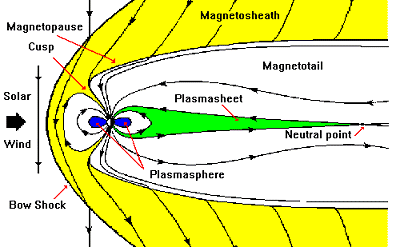
Above: A cartoon of Earth's magnetosphere, from the Oulu Space Physics Textbook.
The sun is a big magnet. Our star has an internal dynamo that generates a strong magnetic field. The solar wind carries this magnetic field throughout the solar system.
Earth has a magnetic field, too. It forms a bubble around our planet called the magnetosphere, which deflects solar wind gusts. Earth's magnetic field and the sun's magnetic field come into contact at the magnetopause: a place where the magnetosphere meets the solar wind. Earth's magnetic field points north at the magnetopause. If the sun's magnetic field points south -- a condition scientists call "southward Bz" -- then the sun's magnetic field can partially cancel Earth's magnetic field at the point of contact.

When Bz is south, that is, opposite Earth's magnetic field, the two fields link up. You can then follow a field line from Earth directly into the solar wind and eventually back to the sun. South-pointing Bz's open a crack through which energy from the solar wind can reach Earth's atmosphere!
South-pointing Bz's often herald widespread auroras, triggered by solar wind gusts or coronal mass ejections that are able to inject energy into our planet's magnetosphere.
Back to Spaceweather.com